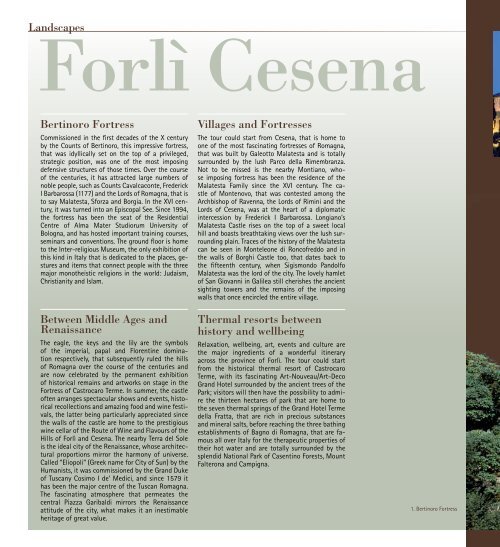of Emilia Romagna
of Emilia Romagna
of Emilia Romagna
Create successful ePaper yourself
Turn your PDF publications into a flip-book with our unique Google optimized e-Paper software.
Landscapes<br />
Forlì Cesena<br />
Bertinoro Fortress<br />
Commissioned in the first decades <strong>of</strong> the X century<br />
by the Counts <strong>of</strong> Bertinoro, this impressive fortress,<br />
that was idyllically set on the top <strong>of</strong> a privileged,<br />
strategic position, was one <strong>of</strong> the most imposing<br />
defensive structures <strong>of</strong> those times. Over the course<br />
<strong>of</strong> the centuries, it has attracted large numbers <strong>of</strong><br />
noble people, such as Counts Cavalcaconte, Frederick<br />
I Barbarossa (1177) and the Lords <strong>of</strong> <strong>Romagna</strong>, that is<br />
to say Malatesta, Sforza and Borgia. In the XVI century,<br />
it was turned into an Episcopal See. Since 1994,<br />
the fortress has been the seat <strong>of</strong> the Residential<br />
Centre <strong>of</strong> Alma Mater Studiorum University <strong>of</strong><br />
Bologna, and has hosted important training courses,<br />
seminars and conventions. The ground floor is home<br />
to the Inter-religious Museum, the only exhibition <strong>of</strong><br />
this kind in Italy that is dedicated to the places, gestures<br />
and items that connect people with the three<br />
major monotheistic religions in the world: Judaism,<br />
Christianity and Islam.<br />
Between Middle Ages and<br />
Renaissance<br />
The eagle, the keys and the lily are the symbols<br />
<strong>of</strong> the imperial, papal and Florentine domination<br />
respectively, that subsequently ruled the hills<br />
<strong>of</strong> <strong>Romagna</strong> over the course <strong>of</strong> the centuries and<br />
are now celebrated by the permanent exhibition<br />
<strong>of</strong> historical remains and artworks on stage in the<br />
Fortress <strong>of</strong> Castrocaro Terme. In summer, the castle<br />
<strong>of</strong>ten arranges spectacular shows and events, historical<br />
recollections and amazing food and wine festivals,<br />
the latter being particularly appreciated since<br />
the walls <strong>of</strong> the castle are home to the prestigious<br />
wine cellar <strong>of</strong> the Route <strong>of</strong> Wine and Flavours <strong>of</strong> the<br />
Hills <strong>of</strong> Forlì and Cesena. The nearby Terra del Sole<br />
is the ideal city <strong>of</strong> the Renaissance, whose architectural<br />
proportions mirror the harmony <strong>of</strong> universe.<br />
Called “Eliopoli” (Greek name for City <strong>of</strong> Sun) by the<br />
Humanists, it was commissioned by the Grand Duke<br />
<strong>of</strong> Tuscany Cosimo I de’ Medici, and since 1579 it<br />
has been the major centre <strong>of</strong> the Tuscan <strong>Romagna</strong>.<br />
The fascinating atmosphere that permeates the<br />
central Piazza Garibaldi mirrors the Renaissance<br />
attitude <strong>of</strong> the city, what makes it an inestimable<br />
heritage <strong>of</strong> great value.<br />
Villages and Fortresses<br />
The tour could start from Cesena, that is home to<br />
one <strong>of</strong> the most fascinating fortresses <strong>of</strong> <strong>Romagna</strong>,<br />
that was built by Galeotto Malatesta and is totally<br />
surrounded by the lush Parco della Rimembranza.<br />
Not to be missed is the nearby Montiano, whose<br />
imposing fortress has been the residence <strong>of</strong> the<br />
Malatesta Family since the XVI century. The castle<br />
<strong>of</strong> Montenovo, that was contested among the<br />
Archbishop <strong>of</strong> Ravenna, the Lords <strong>of</strong> Rimini and the<br />
Lords <strong>of</strong> Cesena, was at the heart <strong>of</strong> a diplomatic<br />
intercession by Frederick I Barbarossa. Longiano’s<br />
Malatesta Castle rises on the top <strong>of</strong> a sweet local<br />
hill and boasts breathtaking views over the lush surrounding<br />
plain. Traces <strong>of</strong> the history <strong>of</strong> the Malatesta<br />
can be seen in Monteleone di Ronc<strong>of</strong>reddo and in<br />
the walls <strong>of</strong> Borghi Castle too, that dates back to<br />
the fifteenth century, when Sigismondo Pandolfo<br />
Malatesta was the lord <strong>of</strong> the city. The lovely hamlet<br />
<strong>of</strong> San Giovanni in Galilea still cherishes the ancient<br />
sighting towers and the remains <strong>of</strong> the imposing<br />
walls that once encircled the entire village.<br />
Thermal resorts between<br />
history and wellbeing<br />
Relaxation, wellbeing, art, events and culture are<br />
the major ingredients <strong>of</strong> a wonderful itinerary<br />
across the province <strong>of</strong> Forlì. The tour could start<br />
from the historical thermal resort <strong>of</strong> Castrocaro<br />
Terme, with its fascinating Art-Nouveau/Art-Deco<br />
Grand Hotel surrounded by the ancient trees <strong>of</strong> the<br />
Park; visitors will then have the possibility to admire<br />
the thirteen hectares <strong>of</strong> park that are home to<br />
the seven thermal springs <strong>of</strong> the Grand Hotel Terme<br />
della Fratta, that are rich in precious substances<br />
and mineral salts, before reaching the three bathing<br />
establishments <strong>of</strong> Bagno di <strong>Romagna</strong>, that are famous<br />
all over Italy for the therapeutic properties <strong>of</strong><br />
their hot water and are totally surrounded by the<br />
splendid National Park <strong>of</strong> Casentino Forests, Mount<br />
Falterona and Campigna.<br />
1. Bertinoro Fortress
















